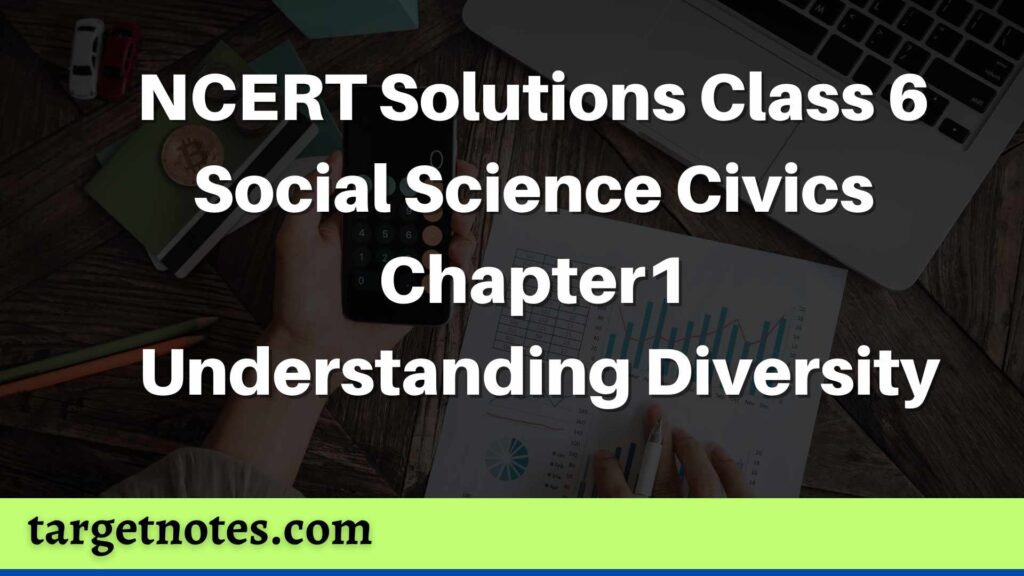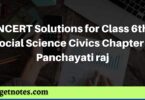
Contents
NCERT Solutions For Class 6 Social Science Civics
Chapter 1 Understanding Diversity
आज हम आप लोगों को NCERT Solutions For Class 6 Social Science (SST) Civics Chapter 1 Understanding Diversity के बारे में बताने जा रहे है इसके अतिरिक्त यदि आपको और भी NCERT CIVICS से सम्बन्धित पोस्ट चाहिए तो आप हमारे website के Top Menu में जाकर प्राप्त कर सकते हैं।
| Board | CBSE |
| Textbook | NCERT |
| Class | Class 6 |
| Subject | Civics |
| Chapter | Chapter 1 |
| Chapter Name | Understanding Diversity |
| Number of Questions Solved | 05 |
| Category | NCERT Solutions |
NCERT Solutions For Class 6 Social Science (S.ST) Civics Chapter 1 Understanding Diversity (Question/Answer)
Q1. Draw up a list of the different festivals celebrated in your locality. Which of these celebrations are shared by members of different regional and religious communities?
Answer:
List of the different festivals with regional and religious communities:
- Holi : Hindus (mainly in North India, North-east India, Orrisa, Maharashtra, Tamil Nadu etc.)
- Diwali : Hindus (mainly in Central India, North India, North-east India, South India etc.)
- Id-ul-Fitr : Muslims (mainly in Central India, North India, North-east India, South India etc.)
- Christmas: Christians (mainly in Central India, North India, South India etc.)
- Pongal : Hindus (Tamil Nadu, Kerala)
- Chhath : Hindus (Bihar, Uttar Pradesh, Jharkhand)
- Lhori: Sikhs, Hindus (Punjab, Chandigarh)
- Mahavir Jayanti : Jains, Hindus (Chhattisgarh, U.P., Bihar)
- Buddha Jayanti : Buddhists, Hindus (U.P., Maharashtra, M.P.)
Q2. What do you think living in India with its rich heritage of diversity adds to your life?
Answer:
Things which rich heritage of diversity adds to your life:
- We met people with different languages.
- We have large variety in foods.
- Celebrate different festivals and respect their cultures.
- Different dance and music forms.
- Variety of dressing styles and clothes of the regions.
Q3. Do you think the term “unity in diversity” is an appropriate term to describe India? What do you think Nehru is trying to say about Indian unity in the sentence quoted above from his book The Discovery of India?
Answer:
Yes, the term “unity in diversity” is an appropriate term to describe India. The diversity in India has always been recognized as a source of its strength. Even during freedom movements, women and men from different cultural, religious and regional backgrounds came together to decide joint actions and opposes the British rule.
This strength of unity made it very hard for Britishers to continue the rule and Indians won the battle of independence. Also, the same national flag was used as means of protest against Britishers everywhere.
In his book The Discovery of India Jawaharlal Nehru says that Indian unity is not something imposed from the outside but rather it was something deeper and within its fold, the widest tolerance of belief and custom was practised and every variety acknowledged and even encouraged. This suggests that despite of having geographical, language and cultural differences, people of India are living with peace with respect for each others traditions and with unity.
Q4. Underline the line in the poem sung after the Jallianwala Bagh massacre, which according to you, reflects India’s essential unity.
Answer:
The blood of Hindus and Muslims flows together today. This line in the poem sung after the Jallianwala Bagh massacre reflects India’s essential unity.
Q5. Choose another region in India and do a similar study of the historical and geographical factors that influence the diversity found there. Are these historical and geographical factors connected to each other? How?
Answer:
Region: West Bengal
Geographical Factors: Lies in the regions of Ganges-Brahmputra Delta. It stretches from the Himalayas in the north to the Bay of Bengal in the south. A small coastal region is on the extreme south, while the Sundarbans forests is a remarkable landmark at the Ganges delta.
Historical Factors: It has close relations with geographical factors. The major population depends on agriculture or mainly the cultivation of rice due to fertile lands of Delta. The people of Bengal supported Bangladesh Liberation war. Durga Puja of Hindus and Eid of Muslims are two main festival celebrated in Bengal.
Region: Kerala
Geographical Features: Situated between the Lakshadweep Sea and the Western Ghats. It has a wet and maritime tropical climate influenced by the seasonal heavy rains. The western coastal belt is relatively flat compared to the eastern region and have many lakes and canals.
Historical Factors: Due to coastal areas, export and import were prevalent and thus there are people from many religions. This state has nearly equal population from Hinduism, Muslims and Christian regions. Festivals like Onam, Eid, Christmas etc. are celebrated. The geographical features helped in the cultivation of spices.
Important Link…
- अधिकार से आप क्या समझते हैं? अधिकार के सिद्धान्त (स्रोत)
- अधिकार की सीमाएँ | Limitations of Authority in Hindi
- भारार्पण के तत्व अथवा प्रक्रिया | Elements or Process of Delegation in Hindi
- संगठन संरचना से आप क्या समझते है ? संगठन संरचना के तत्व एंव इसके सिद्धान्त
- संगठन प्रक्रिया के आवश्यक कदम | Essential steps of an organization process in Hindi
- रेखा और कर्मचारी तथा क्रियात्मक संगठन में अन्तर | Difference between Line & Staff and Working Organization in Hindi
- संगठन संरचना को प्रभावित करने वाले संयोगिक घटक | contingency factors affecting organization structure in Hindi
- रेखा व कर्मचारी संगठन से आपका क्या आशय है ? इसके गुण-दोष
- क्रियात्मक संगठन से आप क्या समझते हैं ? What do you mean by Functional Organization?




